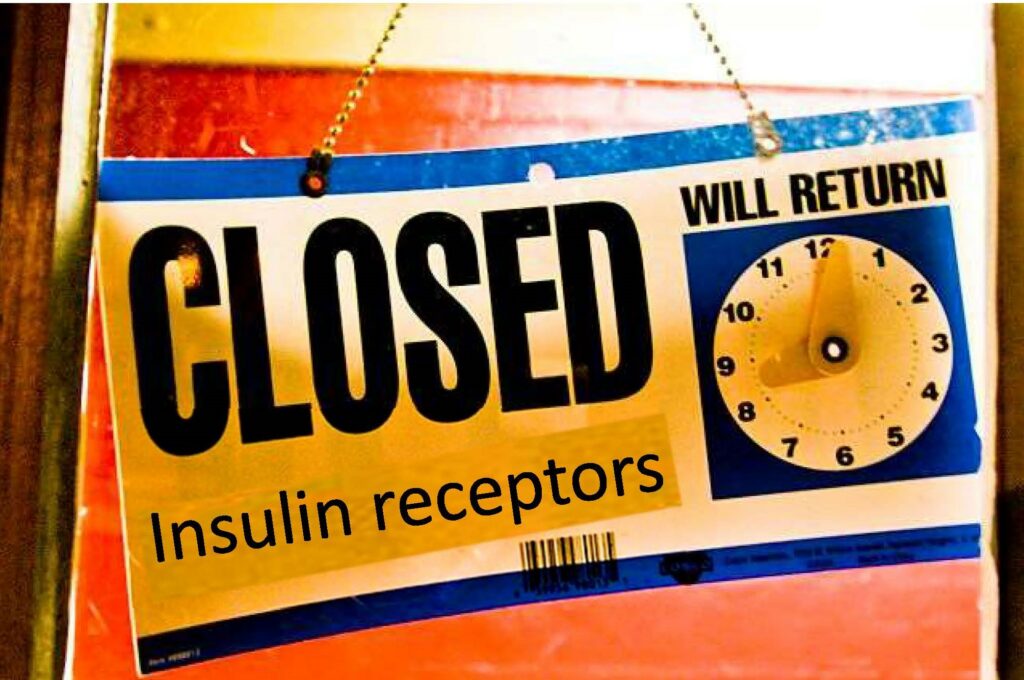We throw this term around as if everyone knows what it means and how it relates to diabetes. Did you know it relates to glucose and your cells? Do you know how to check what your resistance level is? Do you know it involves your pancreas?
Bathing caps on! We are going to do a deep dive into what insulin resistance is and, more importantly, how it affects your disease progression and possibilities of reversal.
Let’s begin with the experts at the National Institutes of Health. This is a quote from the National Institute of Diabetes and Digestive and Kidney Diseases [NIDDKD].[i]
“Insulin resistance is when cells in your muscles, fat, and liver don’t respond well to insulin and can’t easily take up glucose from your blood. As a result, your pancreas makes more insulin to help glucose enter your cells. As long as your pancreas can make enough insulin to overcome your cells’ weak response to insulin, your blood glucose levels will stay in the healthy range.”
All of the above is true, but I would like to break it down because the last sentence has a lot more going on than hoping your pancreas makes enough insulin.
When the NIDDKD says, “liver do[es]n’t respond well to insulin and can’t easily take up glucose from your blood” it means that if these cells can’t get the glucose from the bloodstream into the cells, the cells will not create the energy needed to function.
How does insulin help glucose get into cells?
In a healthy body, insulin works like a key to open the door to the glucose receptors and allow the glucose to enter the cell creating the energy to function.
When you are eating excess saturated fat, generally from animal products or coconut oil, the fat builds up in the muscle cells and liver. This fat creates toxic fatty breakdown products. These breakdown products block the signaling for the receptors to take up the glucose. Additionally, excess saturated fat sits on top of the insulin receptors like gum on a lock. The receptors are “resisting” the insulin from doing its job. The glucose cannot enter the cell and keeps circulating around your body causing havoc. It puts pressure on your retinal nerve, slows circulation in your feet causing neuropathy and pushes the kidneys into hyperfiltration.
There are no symptoms that you will feel if you have insulin resistance. However, indicators that there is a problem are: [ii]
- A waistline over 40 inches in men and 35 inches in women
- Blood pressure readings of 130/80 or higher
- A fasting glucose level over 100 mg/dL
- Patches of dark skin called acanthosis nigricans around the arm pits and neck
How does the pancreas respond to excess glucose in the blood stream?
With an excess of glucose swimming through the bloodstream, the pancreas gets a signal to pump out more insulin. The pancreas goes into hyper drive trying to make the cell receptors to take up the glucose.
“As long as your pancreas can make enough insulin to overcome your cells’ weak response to insulin, your blood glucose levels will stay in the healthy range.” NIDDKD
Can my pancreas stop making enough insulin?
Yes. Here is what can occur when the fat keeps building up in the muscles and liver.
Twin Vicious Cycles
– Fatty Liver Disease and Death of Beta Cells
Cycle 1 – Fatty Liver Disease
The liver is the Grand Central Station of the body. Almost everything ends up there to be filtered. I am always amazed when people tell me they eat liver because “it is healthy”. Every molecule of garbage that entered a body was filtered through the liver. I’m not sure why you would want to eat where the garbage was, but since I don’t have to eat it – no judgement here.
How does the liver affect glucose and why?
Let’s pretend that you ate dinner at 7pm. Then, you went to bed at 10. Your body will be looking for some more glucose around 1-3am. Your liver will get a signal to release glucose to maintain the energy to keep you alive and functioning while you sleep. That is why it stores some glucose. [More about how the liver stores glucose in How does walking 10 minutes after every meal lead to weight loss.] Any time you need a little more glucose, the liver gets a signal to release the proper amount and you continue to breathe and have a working heart. The next morning when you eat breakfast, the pancreas signals the liver that you ate and there is no need to keep releasing glucose. The pancreas has it handled. That’s when you have a healthy liver.
When there is a huge amount of excess fat and glucose over a few years, the liver stores some of the glucose and accumulates a lot of the fat. If the diet continues to have high fat, the liver can develop fatty liver disease. And then, we have a failure to communicate.
The fatty liver is like your mother who just keeps forgetting to turn on their cell phone so they don’t get your voicemail that you can’t come for dinner. The liver has a communication breakdown and does not receive the signals from the pancreas that you ate breakfast. [iii] The liver keeps releasing glucose just like your mom keeps making your favorite Midnight Espresso Cake. Whether it is your liver not listening or your mother not getting your voicemail, it doesn’t end well.
Cycle 2 – Death of Beta Cells
Remember that your whole body is connected. So, the extra glucose released into the bloodstream goes through your eyes, toes, pancreas and lungs. Everywhere.
The fatty liver tries to cleanse itself by dumping out the excess fat into the bloodstream. That fat in the blood also travels through the pancreas where it can amass. The cells in the pancreas that produce insulin are called Beta Cells. The excess fat can begin to kill off the beta cells over time. Insulin production inevitably stutters, and then stops. It is during this killing off period of insulin production that a diabetic will begin administering insulin to themselves.
The next sentence is something I find interesting, and a little distressing, with my diabetic clients. In general, they have never had a discussion with their provider about how healthy their pancreas is. Type 2 diabetes can be slowed, stopped in progression or reversed, but unless you know how strong the pancreas is no one can tell you whether any of these are possible.
How do I know if my pancreas is working?
The best way to know if your pancreas is providing enough insulin is with a C-peptide test. C-peptide is a substance that is created when insulin is produced and released into the body.[iv] A C-peptide test is a blood test. Getting an A1c level in a blood test is important to know about the glucose in your system. A C-peptide test tells you what are the chances that you can change the current trajectory of your diabetes long term.
A low level (or no C-peptide) indicates that your pancreas is producing little or no insulin. A low level may be normal if you have not eaten recently. Below are the levels you are looking for with a C-peptide test:
- Normal level is 0.17 to 0.83 nanomoles per liter (nmol/L)
- Low level is less than 0.2 nmol/l
Are there ways to slow or reverse the progression of type 2 diabetes?
The NIDDKD says to eat healthier foods. Great. They have a link that takes you to the United States Department of Agriculture’s MyPlate.gov page. MyPlate.gov has basic nutrition information and recipes from USDA extension offices located all over the United States. I have done extensive work with the recipes on MyPlate when I wrote the curriculum for the DG3D study. Many of them do not pass my Magic 3’s – Max 6 rule. [See Is diabetes caused by sugar or fat? for rule details.] The fats on most of the MyPlate recipes is much higher than 3 grams per serving I recommend.
Other than “eat healthier foods”, which I am not exactly sure what that means, the other suggestion is to lose weight. Well, that is not a bad plan. However, which foods are best? What exercises can help me after every meal?
I have very specific exercise recommendations [see How does walking 10 minutes after every meal help me lose weight?] to help you stop the progress and possibly reverse this disease and drop a few pounds.
Then, in the very next paragraph is this:
[The Diabetes Prevention Plan] also showed that taking metformin , a medicine used to treat diabetes, could delay diabetes. Metformin worked best for women with a history of gestational diabetes, younger adults, and people with obesity.
Please read what I found out about prediabetes and medications in my Article of the Week – The War on Prediabetes Could be a Boon for Pharma – But is it good medicine? I was really surprised that the information on diabetes jumped from lightly touching on lifestyle changes to naming specific medications such as metformin which has been shown to lower vitamin B12 in long term use.
On the whole, I applaud the work of NIDDKD. Their volume of information assists researchers, like me, to set verifiable parameters for studies and has an education program which sets out the principles needed to create a curriculum that allows for robust investigations covering a multitude of intervention topics. When you are looking at serving a population of 350 million people, you do have to brush with broad strokes.
On the other hand, their lack of meal plans and recommendation of the very high 7% of calories coming from saturated fats is too amorphous for most people to figure out what to do while pushing a cart at the grocery store. Their recommendation of 25 grams of fiber is nice, but the message is not getting through since the average American eats less than 10 grams daily.
The simple fact that you are reading this article points up that the phrase “insulin resistance” is part of the common lexicon, in spite of the fact that the definition of it is not.
As a health educator and personal dietitian, I see that when you understand how a condition occurred and why it is not subsiding, you can begin to create a plan which will turn around the projection of your health. You become the CEO of your vitality. Taking this deep dive into one aspect of type 2 diabetes is worth the time if it connects the dots in bettering your own well-being.
Okay, everyone out of the pool and grab a pen or make notes on your phone as to next the steps you are going to take to resist “insulin resistance”.
[i] https://www.niddk.nih.gov/health-information/diabetes/overview/what-is-diabetes/prediabetes-insulin-resistance#prevent
ii] https://www.webmd.com/diabetes/insulin-resistance-syndrome
[ii] https://www.ncbi.nlm.nih.gov/pmc/articles/PMC6359196/
[iv] https://www.ucsfhealth.org/medical-tests/insulin-c-peptide-test#:~:text=C%2Dpeptide%20is%20measured%20to,body%20is%20still%20producing%20insulin.
[i] https://www.niddk.nih.gov/health-information/diabetes/overview/what-is-diabetes/prediabetes-insulin-resistance#prevent

